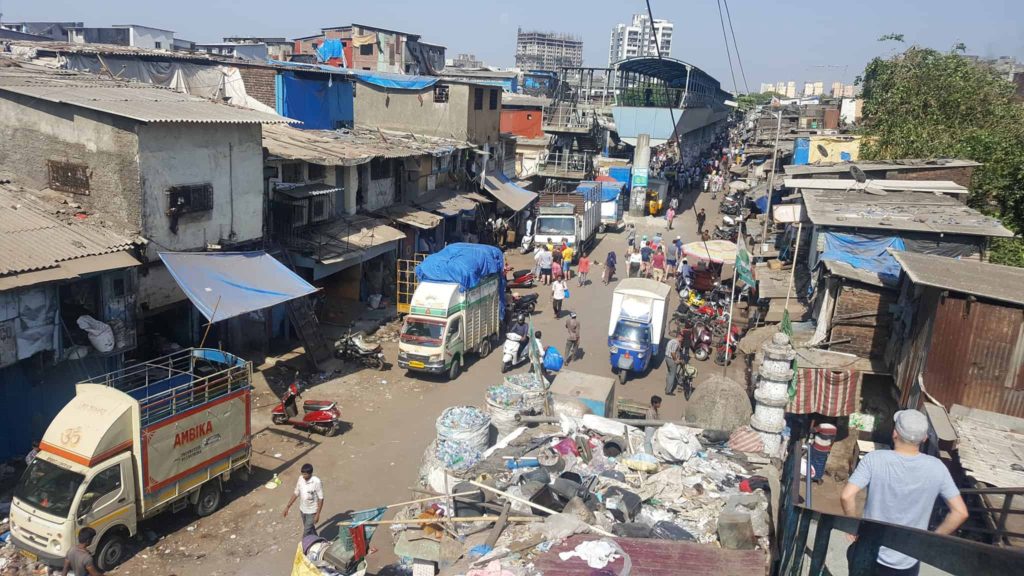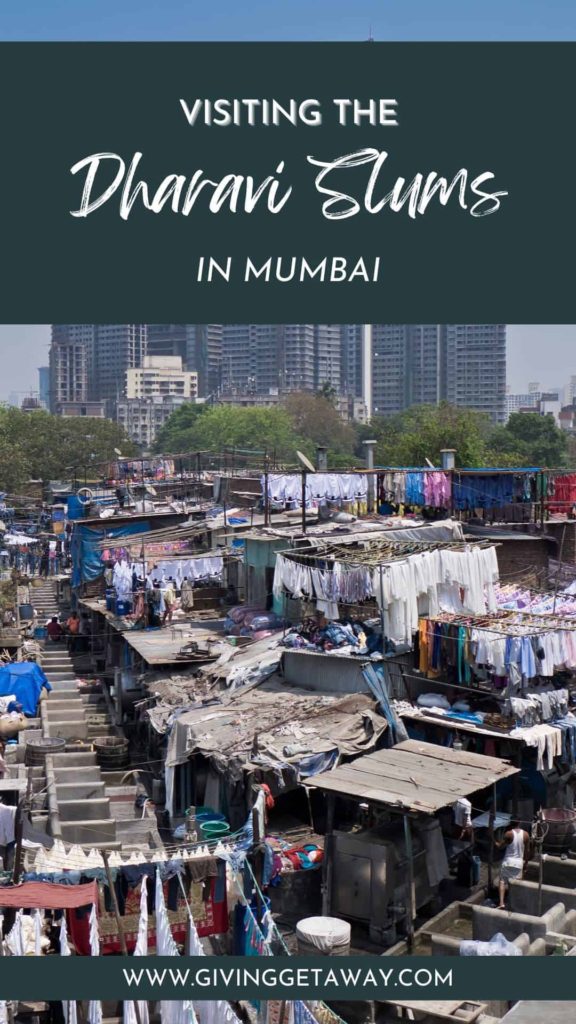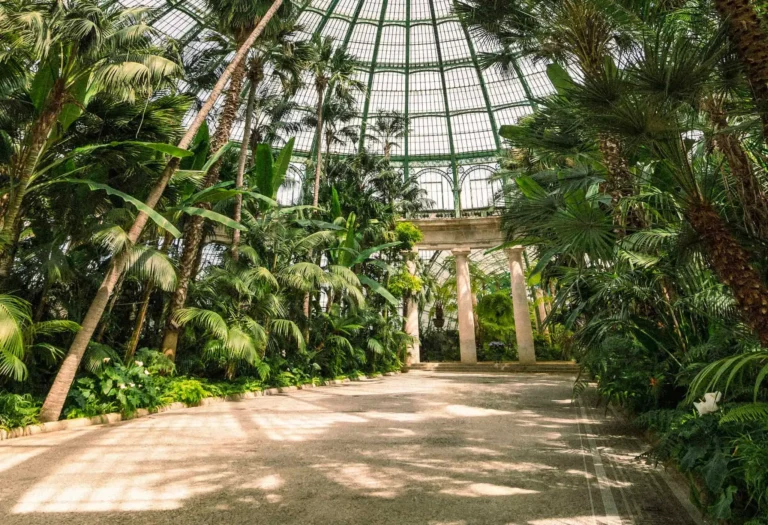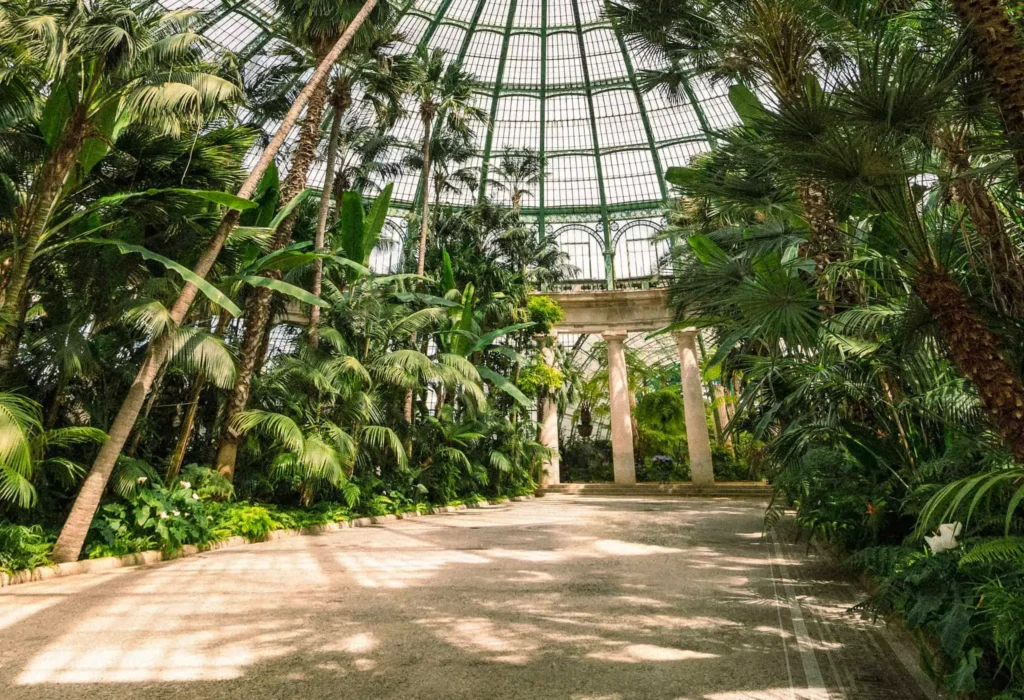| This post may contain affiliate links. Whenever you book or buy something through one of these, Giving Getaway gets a small commission, of which 100% will be donated to charity, without any extra cost to you! |
India, Mumbai on a hot and humid summer day. The monsoons are coming soon. Grey smog above the city is darkening the sky and I cannot see the sun, although I know it has to be there. We get off the bus next to the railway station and meet a young guy, a Hindu named Suraj on the footbridge over the tracks. Today he will be our guide when we visit the Dharavi slums in Mumbai, the largest slum in Asia and the third largest in the world.
Almost one million people live here on not even 3 square kilometers, making it the most densely populated place in the world. The number of people who are usually trying to escape from poor villages or places hit by natural disasters keeps rising every day.
1. Stepping Into Another World
The first time I saw this slum was from an airplane. It is not difficult to notice this strange, colorful, and chaotic area which stands out so clearly from the surrounding high-rise buildings.
The huts in the slums are made of everything the dwellers can find: sheet metal, plastic, foil, and cardboard. It looked like a chaotic construction of Lego blocks that didn’t really fit in and that were attached in a completely random manner. Together with Suraj, we cross the footbridge over the tracks.
We stop for a moment and Suraj explains to us the rules of visiting slums: “We stay together, you only walk the streets that I will lead us to and you don’t enter the buildings alone. You are completely safe with me, but this is a slum.
You will find a gun here in every house” explains Suraj. And the most important rule is that photography for me means preserving memories, feelings, and images: “You are not allowed to take photos in the slums.”

After all, I was about to enter a whole new world, and to me, it was beyond all question to respect the prevailing rules and to treat them as a binding contract. We were allowed to take one photo from the high footbridge; a bridge that was like a transition to another world – with one of the largest slums in the world right on the other side.
While standing on the footbridge, I still wasn’t entirely sure what to expect. The word “slum” creates images in my head, pictures of a country where contrasts are omnipresent. I imagine seeing extreme poverty and thinking of the world-famous movie “Slumdog Millionaire”, in which the main character grew up in the Dharavi slum.
2. Dharavi – A Living Organism
We head towards the stairs which lead to the slums and in the meantime, Suraj tells us more about himself. He grew up and still lives in Dharavi, studies computer science, follows hacker movements, and has a plan to work at the bank as soon as he graduates. Suraj talks about his plans with conviction as if everything had already been agreed upon. We go down the stairs and follow the broad and crowded main street of the slum.
You can see garbage everywhere which is not unusual here in India, but here, in this chaos, seems to be the principle to separate plastic from the rest. Suraj begins to assume his role of a guide: “To your right, you can see bakeries, dress shops, a mosque, and a cinema.“ “A Cinema?”, I ask. “Well, of course,” Suraj replies, “we love cinemas. Did you watch our Indian movies? We like love stories, but I also watch action movies from time to time.”
We start strolling through one of the side streets in the city within the city; an organism that seems to live its own life and which minute by minute begins to resemble an organized enterprise rather than a district of poverty. The streets are narrow – sometimes only 30-50 centimeters broad, stuffy, dark.
We must watch our heads because of cable tangles hanging from above. It strikes me that I only see men crossing our path and only once in a dark corridor I see a woman preparing a meal. Half-naked children play in the narrow, muddy streets. They are smiling, waving at us, and giving us high fives when we pass.

What are they doing there anyway? Current figures show that more than 80 percent of Mumbai’s entire garbage goes to the slums. Plastic processing is like a huge machine with a production line that is divided into different stages. Before the plastic can be formed into fine, colored granules, it must be processed by hand – and everyone seems to be happy and proud to present their work.
The entire plastic recycling process even has its official website where you can read more about every single step: collecting, grinding, washing, drying, and pellet production. There you can also find a map with all workshops and after closer examination, you will notice that there is no place for random actions and that the whole process is carefully planned.
Unfortunately, the whole process is a long way from fulfilling any kind of health and safety standards. Everything is done with bare hands and in many cases plastic dust penetrates the lungs. We keep observing the plastic process while one man proudly presents the outcome – pellets and plastic granules. He also lists several global companies that use their plastic, and I know most of them.
3. Supplier for Luxury Stores From All Around the World
I ask Suraj how much the slum dwellers earn. “100 to 300 rupees per day”, he answers, which is about 1.50 USD to 4.50 USD per day. According to Wikipedia, Dharavi’s annual turnover is valued at about 500-650 million USD. But plastic processing is only one of Dharavi’s branches of industry.
The slum absorbs almost everything that can be processed. I see one manufactory whose job is to clean paint cans and other chemicals by hand. Here, too, is a sharp chemical smell in the air which makes it hard to breathe.

But we have a problem with running water, which is accessible for only three hours per day for more than one thousand people who use one toilet.” My imagination starts to go crazy and I try to change the subject: “Suraj, did you watch the movie ‘Slumdog Millionaire?’” “Yes, but I didn’t like it. The movie shows the terrible side of the slums, poverty, and the land of lawlessness. Life in Dharavi is not like that”, Suraj grins.
4. Seeking the Truth About Dharavi
So what is it really like, the third-largest slum in the world? Is it a district of extreme poverty, dirt, and lawlessness? Or is it an organized machine, the promised land with work and a roof over people’s heads? As is mostly the case, I believe that the truth lies somewhere in the middle.
But more questions come to my mind. Thinking about my presence in the slum, I do know that it’s controversial as it is part of the increasing and widely criticized tourism of poverty.
Yes, I was in the slums on a ‘touristic trip’, commercially organized by local tour operators. Tourism of poverty gives rise to a lot of emotions – and questions like what is the goal, why do people want to enter these districts of poverty? Do they just strive to feel better? Here, too, I struggle to think of a definite answer, but at least I know my answer.
It is not our merit where we were born, whether in New York, Berlin, in the Sudanese desert, or the Mumbai slum. For me, visiting the Dharavi slum was a very deep and powerful experience. I expected extreme poverty and dirt, but instead, I saw happy people proudly presenting their work. Sure, the slum dwellers are facing difficult living and working conditions, both sanitarily and economically.

But even if he would have let me see the plain truth, would it have been possible to find objective, definite answers to all these questions? Does full objectivity exist anyway, anywhere in this world?
Perhaps there is one more question in your mind: why not simply visit the slum without a tour guide? Why not discover everything by yourself, turning whenever and wherever you want and talking to all the people you want? I will answer this question unequivocally: please don’t do this. Why?
You are in a country with almost 1.5 billion people, you are in a country with huge social differences, where caste life is a natural part of social division. You are in a country where women reported 34,000 rapes only in 2018, and the estimated number of unknown cases is probably much higher since most delicts in India remain unreported.
Conclusion
It doesn’t matter if you are black or white and if you are not Indian, you will always attract attention on the streets of India. You will see many smiling people who will come to you to say hello, maybe even ask if they can take a picture with you. But those who want to deceive or harm you will also recognize you.
I don’t want to keep you from going to India. Go, you will meet wonderful and open-hearted people, but always be careful and don’t take unnecessary risks. And if you are looking for a slum life that will change your life, and influence your inner path, read the amazing book “Shantaram” by Gregory David Roberts (but remember that the main character is a criminal who later works for the mafia, even if he has huge sympathy for the reader).
Follow Ania on Instagram to see more beautiful pictures of her travels and to find more interesting travel tips and stories. And to make sure that your trip to Mumbai and India will be an unforgettable once-in-a-lifttime experience, check flights, hotels, taxis, tours, and more right here on our website.
With every booking you complete by using one of our links, we donate 50% of each commission to charity. This way you will enjoy your trip and do something good at the same time!

















